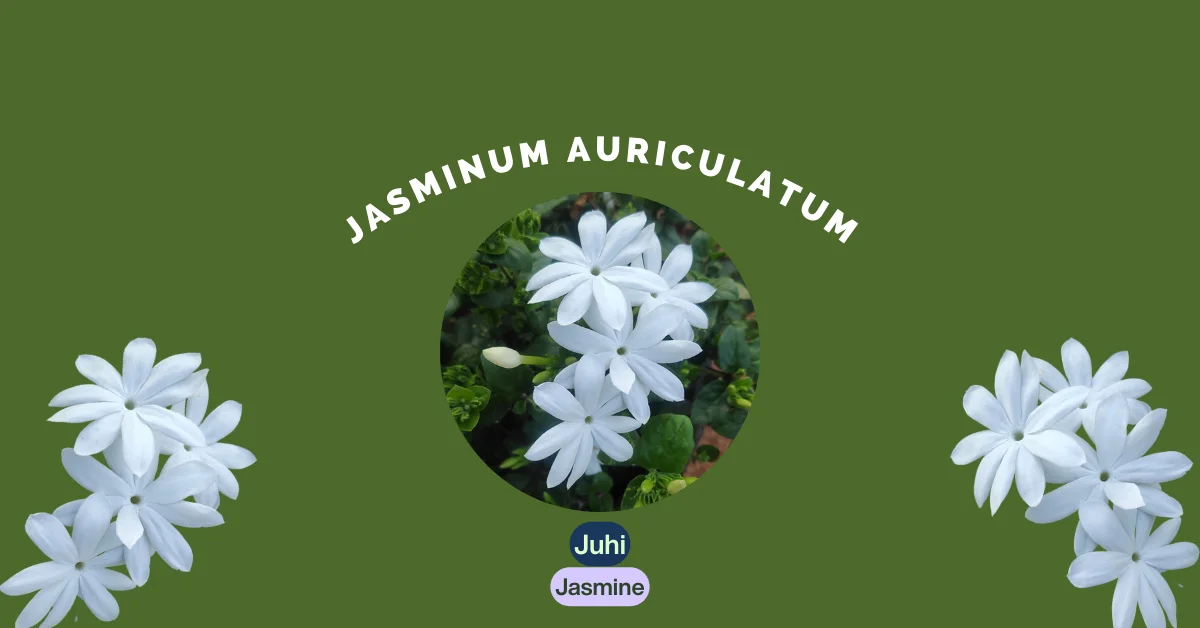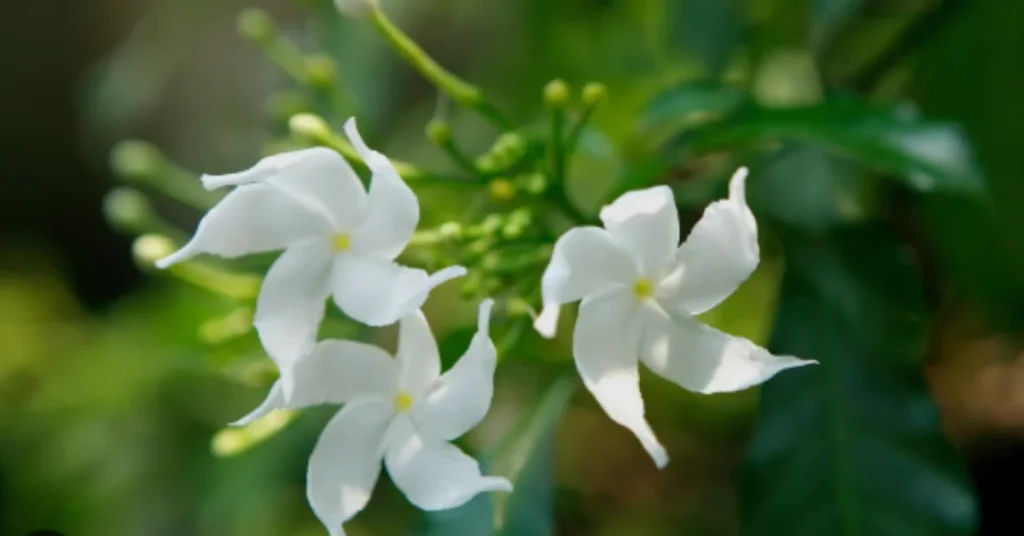Jasminum Auriculatum (Juhi) – Growing Guide and Uses

The fragrant floral Jasminum auriculatum, also known as Juhi, is popularly used in perfumes industry. This jasmine contributes a complex, aromatic note to perfume compositions. Its scent is unique as compared to other types of jasmine. Located in South Asia, Jasmine Auriculatum is a small flowering shrub in the jasmine family. The flower is mostly used for religious ceremonies and hair garlands.
This species of jasmine belongs to the Oleaceae family. Its natural habitats include India, Nepal, Sri Lanka, Bhutan, and the Andaman Islands. Common names for Jasminum auriculatum include Jasmine molle, Indian Jasmine, Juhi, Jui, and mulai. This plant has distinctive evergreen perennial flowers. Indian and Thai farmers do jasmine farming and cultivate it commercially because of its essential oil.
Indians use it in festivals and for decorative purposes. It grows rapidly in landscapes. When it’s full bloom, it’s extremely fragrant. The fragrance of Juhi Jasmine makes it stand out among other jasmine types.
Characteristics
| Botanical Name | Jasminum auriculatum |
| Common Name | Juhi Jasmine |
| Family | Oleaceae |
| Growth Form | Climber, Shrub |
| Native | India, Nepal, Sri Lanka |
| Nutrition | Autotrophic |
| Climate | Tropical |
| Flower Color | White |
| Flower Shape | Star Shape |
| Size of Flower | Small to medium |
Morphological Characteristics
This plant holds simple dark green leaves and grows to a height of 2–3 meters as a compact shrub. During blooming seasons, several times a year, the plant may display powdery satin white flowers. It has opposite, soft and velvety, simple, or trifoliate leaves. As opposed to the lateral leaflets, which are much smaller, rarely exceeding 4 millimeters in diameter, the central leaflets are up to 3.5 cm long, ovate and pointed. Several oblique nerves are present at the bottom. It has linear bracts measuring 4 mm in length.
Many-flowered cymes produce fragrant flowers. Flower stalks can reach a length of 5 mm. The calyx measures 3 mm long, is pubescent, and has minute teeth. The flowers are white, longer than 1.5 cm, and have elliptic lobes. A 5 mm diameter, globose, blackberry is found. The most abundant blooming occurs during the hot summer months. Flowers may also bloom in the Fall and even in the Winter.
Optimal Growing Conditions
It thrives in warm, humid climates in India and other tropical regions of Asia. It is also adaptable to subtropical conditions.
Climate Conditions
Warm, sunny conditions are ideal for this plant. Although it can tolerate partial shade in some situations. This plant needs direct sunlight for at least 4-6 hours each day to produce abundant blooms. You can encourage the plant’s growth by placing it in front of a southern-facing window. Direct sunlight isn’t needed as much during the winter.
Watering Needs
Like any other flowering vine, it is a thirsty plant when it is established in a pot. This plant needs lots of water during bloom time. The resting period following bloom decline requires less water. However, avoid overwatering the plant when you first plant it in the pot as this may cause its roots to rot quickly.
Soil Requirements
Ideally, Jasminum auriculatum should be grown in well-draining, slightly acidic to neutral soil with a pH between 6 and 7. It is best to use loamy soil enriched with organic matter. Soil should always be kept slightly moist. Maintain a moist soil mixture throughout the year, without becoming soggy.
Jasminum Auriculatum Cultivation
Planting
The best time to plant jasmine is in the spring or early summer. It is recommended to sow seeds in a seed tray or pot, while saplings can be transplanted directly into the ground or larger containers. Ensure moderate watering and a sunny position. I do advise a fertile, humus-rich, and well-drained soil for this plant.
Fertilization
The plant isn’t so fertilizer-hungry. During the growing season, fertilizer should be applied every four to six weeks. Well-rotted manure or compost are excellent organic fertilizers.
Pruning
Plants benefit from regular pruning because it maintains their shape and enhances their flowering. Prior to the onset of new growth, it is best to prune in late winter or early spring.
Propagation
Juhi Jasmine is surprisingly easy to grow. You can have a garden bursting with these fragrant stars!
1- Cuttings:
In this popular method, healthy sections of a parent plant are planted to produce new plants. The steps are as follows:
- An early morning propagation is ideal in the spring or late summer during the pre- or post-monsoon season.
- Approximately 4-6 inches long, healthy, non-flowering shoots should be selected. It is ideal to choose stems with at least two nodes (small bumps where leaves emerge).
- Make a clean, sharp cut just below a node with a knife or pruning shears. The bottom inch of the cutting should be cleared of leaves to promote root growth.
- Adding rooting hormone powder to the cut end can increase rooting success, though it is not strictly necessary.
- Mix equal parts of sand, loam, and peat moss to form a well-draining potting mix. Dig holes in the mixture and gently plant the cuttings, burying at least one node.
- Use a clear plastic bag or humidity dome to cover the pot and mist the cuttings. As a result, roots are able to develop in a warm, humid environment.
- Keep the pot out of direct sunlight and in a warm, bright area. Maintain a consistently moist soil without overwatering. It usually takes 4-8 weeks for the roots to develop.
- The appearance of new growth indicates a successful root system. Before transplanting the plant to a larger pot or your garden, gradually adapt it to outdoor conditions.
2- Layering:
The layering method is equally effective, especially for established plants:
- A healthy, flexible branch close to the ground is best.
- Remove a small piece of bark from the underside of the chosen branch by scraping or nicking it. As a result, root growth can be stimulated.
- You should bend the branch downward and bury the wounded part a few inches deep in moist soil. Secure the branch with a small rock or landscape pin.
- Make sure the soil is consistently moist. Eventually, roots will grow from the buried portion.
- You can transplant the layered branch from the parent plant once new growth appears and the roots are established (usually within a few months).
Jasminum Auriculatum Uses
Its versatility and ease of maintenance make it popular plant among gardeners and they grow it for many purposes:
Borders and Hedges: Pruning Jasminum auriculatum regularly creates a fragrant border for garden spaces when grown as a hedge.
Potted Plants: Jasminum auriculatum do well in containers, so they are good to be planted on balconies or patios if you don’t have a backyard.
Climbers: They can be trained to climb on trellises or arbors and thus add vertical interest to a garden with proper support.
Essential Oils: Steam distillation is used to extract the essential oil from the flowers of this plant. High end perfumes often use the oil for its sweet, floral aroma.
Cosmetics: In skincare products, jasmine extract is commonly used for its soothing and moisturizing properties. Lotions, soaps and creams contain it for its aroma and skin benefits.
Medicinal Uses and Benefits
Jasminum auriculatum’s uses include:
- A decoction of Jasminum auriculatum roots is consumed for relief from urinary and renal disorders.
- The origins and leaf are used as an infusion for gum and oral cavity problems.
- The leaves of jasmine can be used as a poultice to relieve headaches or muscle pain. Rural areas commonly use this remedy.
- The anti-inflammatory properties of the plant’s leaves and flowers have made it a traditional medicine. It is often applied to rashes and inflammations on the skin as a paste. Additionally, the Jasminum auriculatum seeds and leaves are capable of healing wounds.
- The paste made from its origin is used to treat headaches and eye problems.
- In fact, it is said to be beneficial to the health of the heart.
- The essential oil of Jasminum auriculatum is used in aromatherapy for its calming effects and to reduce anxiety.
Conclusion
This jasmine plant is a good addition to any garden or patio. The sweet aroma and stunning appearance of Jasminum auriculatum are sure to brighten your day. Further, they are among the easiest plants to maintain around your home. This jasmine specie provides beauty and utility in addition to its aromatic flowers.
Its fragrant oils, medicinal benefits, aesthetic appeal and what’s more? It is almost a year-round pleasure to see them!

I am Yasir Riaz, an Agronomist for more than a decade. Helping local farmers and Gardeners to improve their crops and Gardens and overall productivity. In addition to my work in agriculture, I have also delved into the digital world as an SEO writer and blogger. Through my blog, I aim to educate and inspire others about the Chameli Flower (Jasmine).






